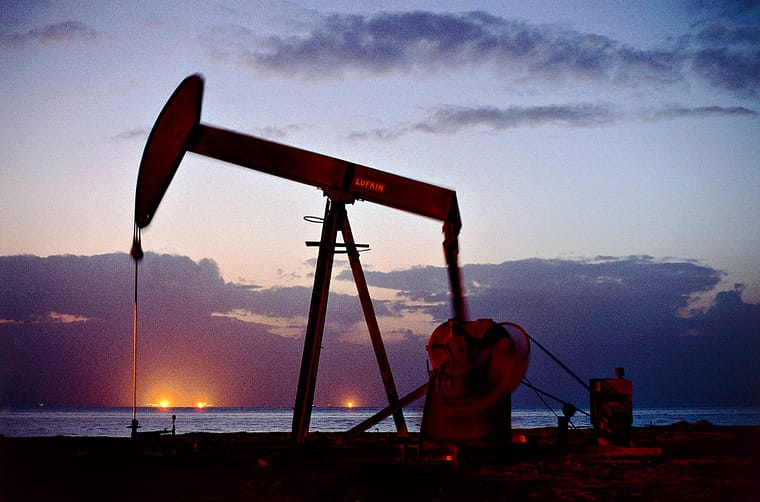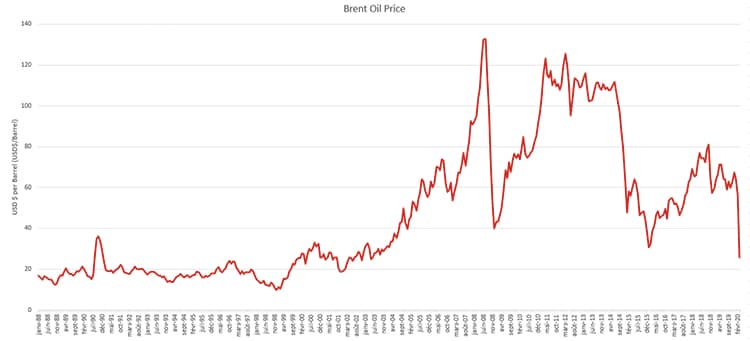17.07.2024
Oil tsunami, the shock… then the crunch?
Tribune
23 mars 2020

The unexpected outbreak of the COVID-19 epidemic and its recent wide spread throughout the world has been a real « black swan » for the oil markets. No one expected such a sharp and spectacular fall in oil prices over the last few weeks. Anticipation of a severe slowdown in the world economic growth, particularly in China which is the world second largest oil consumer, had already triggered a decreasing trend of a few dollars per barrel in the first weeks of the sanitary crisis. However, it is the recent volte-face in the OPEP+ alliance, especially from the Russian and Saudi strategies, which created a shock in the markets.

Figure 1: Brent oil prices (US$/bbl) between 1988 and 23/03/2020. Source : Reuters
Following the failure from last week OPEP+ negotiations in Vienna, oil price loosed up to 55%. The Brent closed at US$25.62/bbl on March 18, 2020, a record low in 20 years. Moreover, a rise in prices is not expected in a near future, with analysts forecasting that it could even fall below $20/bbl. Indeed, Saudi Arabia along with Russia, Kuwait, the United Arab Emirates and potentially Libya have announced plans to increase production to record levels. Although the market had already been oversupplied for several months, an additional three million barrels per day (mb/d)[2] is expected on the market in April, and even more in May.
Taking advantage of those low prices, states throughout the world are drastically increasing their strategic reserves, maintaining a somewhat ‘artificial’ and temporary demand. But this momentum could quickly run out of steam once storage capacities become full, adding even more excess to the supply in the coming weeks.

Figure 2: Expected month/month oil production variation from OPEP+ members following the recent announces.
Source : Rystad Energy
In addition, the gap between production and consumption is expected to keep growing as the COVID-19 epidemic continues to cripple economies around the world. First estimations from Rystad Energy predicts that the epidemic could reduce global demand for petroleum products by more than 10 mb/d in April 2020. On average, it would represent up to 10% over the year compared to 2019. Meanwhile, estimations of economic growth and oil consumption are all being revised downwards by institutions such as the International Energy Agency or European Central Bank along with several private players, including investment banks such as Goldman Sachs.
Although oil companies have drastically reduced the production cost per barrel after the 2015-2016 oil crisis (caused by the emergence of the unconventional U.S. shale industry), no producer can sustain a barrel price below $30 in the long run. A large majority of oil global break-even production thresholds is falling into this range (cf. Figure 4), which means that a large majority of the industry will record significant loss of profits in the short term with null or even negative cash flow. And they won’t be the only victims since oil-producing states, especially those whose revenues heavily rely on this resource, will no longer be able to balance their budgets. As seen in 2016, this situation exposes them to significant political and social risks that may in the mid-term affect their production capacities, as it has been the case in Venezuela or Libya.

Figure 3: Share of oil rents as a percentage of GDP vs. share of fuel exports as a percentage of merchandise exports for the most exposed countries to the fall in oil prices. Source: World Bank (data 2017)

Figure 4: Breakeven (US$/bbl Brent) vs. Capacity in 2030, updated to 2018. Source
As a consequence, and even if they became more resilient compared to the last oil crisis, the most fragile and exposed small and medium-sized oil and service companies will certainly have to go out of business unless significant support or nationalization plans are put in place. In Europe, for example, Rystad Energy foresee that up to 20% of oil-related service companies could face risks of bankruptcy, i.e. more than 200 companies, mostly in Norway and England.
Another pattern from the past is then likely to be reproduced: private and national oil companies will focus their efforts on maintaining their production activities at the expense of exploration and research and development. Twenty-two oil producers including Saudi Aramco, Sonatrach, ExxonMobil, Total, Equinor, BP, Chevron, Eni and the biggest U.S. unconventional producers announced cuts in their investment for 2020 and probably 2021. In the U.S. only the cuts already announced are reaching 7.6 billion dollars[1], it could represent tens to hundreds of billions around the world.
This crisis will therefore further weaken the upstream oil sector, which is already vulnerable (decreasing size and numbers of discoveries, environmental pressure, lack of talent, etc.), and its ability to find and replace produced reserves, which we critically need. Indeed, in an analysis[2] recently published, we already highlighted and detailed those facts and their potential risk of creating an ‘oil crunch’ by 2025, in the pre-COVID-19 context. As a recall, the peak of conventional oil production had already been reached in 2008[3] and the last potential reliable source of growth in oil production according to the International Energy Agency were the U.S. unconventionals.
The current COVID-19 epidemic and its consequences on global economies can only intensify the risk of a tight supply situation in the mid-term. Obviously, a lower consumption for months or years will have a positive impact on remaining reserves and production. Without new agreement from OPEP+, it will likely leave the market oversupplied and keep the prices down for long, dragging the industry down with him and all those who rely on it.
More worryingly, the recent decisions from Saudi Arabia and Russia to add those millions of barrels on the market could suggest that world production capacities can easily be adjusted at convenience, up or down. In reality, it is only true in the short-term, based on some flexibility from fields already in production. As soon as the natural decline in field productivity has to be compensated by bringing new discoveries on stream, delays will be observed, with the average time between discovery and start of production being 2 to 4 years. The current oversupply situation could easily be switched into an undersupplied market in a matter of years.
At the moment, recent analysis estimates that up to 80% of the 100 mb/d consumed each day[4], or the vast majority of fields, is declining exponentially at an annual rate comprised between 4% and 8%. Moreover, the International Energy Agency made a clear warning that the main source of production growth that could potentially meet future demand by 2025 would be the U.S. shales[5], which is one of the targets, and probable victims, of the price war being waged by the Russians and Saudis. If investment in exploration and production of new fields, which are already at record lows, are cut even further along with the weakening of the U.S. unconventional industry: where will the new oil supply come from?
Under 40$/bbl, it is hard to picture the future of the energy sector with confidence. First of all, insufficient sanctions of new development projects will threaten our oil supply security in the mid-term. It will also delay or even cancel funding for low-carbon alternatives which, if not supported, will de facto become less attractive to end users drowning under cheap oil.
One possible and positive way out from this health and economic crisis would be to put an end and deeply transform a globalized system that has proved to be more and more unsustainable. Unexpected benefits from the COVID-19 epidemic and the lower consumption of fossil resources can directly be seen through the immediate reduction of air pollution in China or Italy. Reducing our oil consumption and slowing down its exploration could then be the first practical steps towards strong commitments into a deep energy transition and the war and adaptation against climate change.
However, another scenario is even more likely to occur: low oil prices will boost the economic machine as soon as we will have overcome the COVID-19 crisis and will be at the origin of many rebound effects, bringing oil consumption back to pre-COVID-19 levels, and even beyond. In this case, the risk of a supply crunch as a result of insufficient investment in exploration and production clearly remains. As is the risk, also systemic, of a failed timing between a needed energy transition and future global recovery policies.
—————————————————–
[1] Oil companies’ websites
[2] Non-sufficient production to meet demand
[3] International Energy Agency, World Energy Outlook 2018
[4] Global Oil Supply – Peak Oil Report – HSBC Global Research Fustier et al., 2016
[5] International Energy Agency, World Energy Outlook 2018